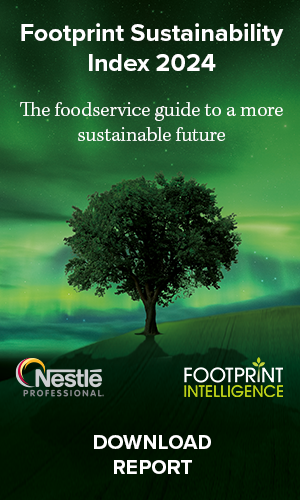A Footprint investigation has discovered that large volumes of new compostable packaging from the Houses of Parliament are being sent for incineration due to shortcomings in the waste supply chain. By Nick Hughes.
More than a year after UK Parliament first announced plans to switch to new compostable packaging, Footprint can reveal that none of the packaging has actually been composted.
Our investigation has uncovered that all of the compostable waste collected in an initial load since new packaging was introduced in October 2018 has had to be incinerated after the load, including cups and food boxes, was contaminated with non-compostable materials.
Of the 6.5 tonnes of waste collected in designated compostable waste bins between October 2018 and May 2019, Parliament estimates that half was compostable with the remainder consisting of non-compostable packaging.
In May 2018, Parliament announced its plan to introduce a range of measures to drastically reduce its consumption of traditional single-use plastics from both the House of Commons and House of Lords, replacing them with compostable or reusable alternatives.
New plant-based products supplied by Vegware were introduced in October including certified compostable single-use cutlery, coffee cups and lids, soup containers, takeaway food containers, salad boxes, and drinking straws. In a press release issued in September, Parliament said an in-vessel composting (IVC) method would use a combination of heat and microbes “to turn the waste into compost fit for any garden”.
However, Footprint’s investigation shows that since making the commitment:
- Parliament’s waste contractor Bywaters has been unable to send the waste generated during the first seven months of the switch to compostable packaging to an IVC facility for composting
- all of the compostable waste collected between October 2018 and May 2019 was sent to an energy from waste plant for incineration
- Parliament has been forced to invest almost £70,000 a year to develop its own bespoke waste stream for compostables
- compostable waste from Bywaters’ other London-based clients is not currently being composted due in part to a lack of London-based IVC facilities
The new waste stream will see compostable waste collected separately from Parliament by Bywaters and sent to a facility in Leyton, east London, where it will be compacted and bulked before being transported to an IVC facility in Cambridgeshire once a suitable proportion of recoverable waste has been collected.
The revelation that no waste has actually been composted so far highlights the challenges faced by organisations in ensuring that compostable packaging is being disposed of in the most responsible way.
Last year, Footprint revealed that commitments by foodservice businesses to switch to compostable straws were being undermined by an inability to capture the waste and dispose of it properly.
Speaking at an event in June, shadow waste minister Sandy Martin said he believed that “a large proportion” of the compostable items available across the Parliamentary estate are not composted.
In a statement Parliament said: “Whilst our initial compostable waste load could not be composted, work is ongoing to ensure that our customers dispose of compostable waste appropriately. In July, we will send our first fully compostable load for processing.”
Parliament has deemed it necessary to invest £68,000 a year to create a bespoke supply chain to make good on its commitment to turn compostable waste into compost and to help meet its target to reduce the amount of waste generated by weight by 30% against a 2008/09 baseline and to recycle 75% of waste generated by weight by 2020/21.
Its aim of eliminating single-use avoidable oil-based plastics from both houses of Parliament has already delivered some notable achievements. At the same time as substituting plastic-lined, single-use disposable cups for compostable alternatives, Parliament introduced a 25p surcharge on all hot drinks to encourage customers to instead use a china mug or a re-useable “keep cup”. The measure has resulted in a reduction in monthly sales of hot drinks in single-use disposable cups from 58,000 to 15,000 with no negative impact on overall sales.
To help people recycle their compostable waste, a new three-bin system has been introduced in offices, tea points and kitchens across the parliamentary estate to separate general waste, dry-mixed recycling and compostable products. Around 800 dedicated compostable waste bins were distributed during September to help “takeaway” customers dispose of their items correctly. Compostable waste is disposed of together with any residual food waste remaining on the item.
Prior to the switch to compostable products most of the takeaway packaging materials from catering outlets were disposed of via the general waste stream due to the material being contaminated with food.
Parliament has also carried out engagement activities to ensure customers are disposing of products in the appropriate way. Communications campaigns have been run via the parliamentary intranet, team newsletter articles and “drop-in” stalls in buildings; guidance materials including a range of posters, bins labels and FAQs have been developed; and employees have taken part in floor walks to give colleagues the opportunity to ask questions or gain further information.
Despite all this, and the fact that cleaning and logistics staff have been trained to monitor the three-bin system for contamination, the first batch of compostable waste was too heavily contaminated for it to be successfully sent to an IVC facility. Parliament says contamination has decreased considerably over time as users have become familiar with the three-bin system and developed new habits. It adds that use of compostable products is now significantly higher than in the early stages of the move away from single-use plastics, which has further lessened the impact of any residual levels of contamination.
Parliament is confident that levels of contamination of a new load of compostable waste collected since May will be much lower, allowing the load to be sent to the Cambridgeshire facility. It insists that none of the product will be diverted to anaerobic digestion (AD), in which food waste is converted into energy and digestate. AD facilities are able to treat a small amount of compostable packaging along with food waste loads, although the tolerance level is low at a maximum of around 20%. In the UK, IVC is considered to be a more sustainable way of disposing of compostable packaging than AD.
AD sites tend to pull out packaging, including compostables, before treatment. Some companies have successfully bolted IVC facilities onto their sites in order to process the “soup” of material and food residue that the de-packager scrapes away, but there is unlikely to be a rush to invest in expensive refits. A dramatic reduction in contamination from conventional plastic would help but compostables aren’t ideal for wet AD (the predominant technology in the UK) unless there is a post-digestion aerobic phase. The Bio-Based Industries Association has called for “complementary synergy between AD and composting” to ensure compostable materials are composted.
The other option is to develop products that can be treated at AD. The government will soon issue a call for evidence on the development of standards for bio-based and biodegradable products. Linda Crichton, part of DEFRA’s waste policy team, said recently that compostable packaging may well have to be both compostable and digestible in order to align with the UK’s AD infrastructure.
Final decisions are a long way off, however. By investing in its own infrastructure, Parliament is trying to find a long-term sustainable solution to a complex problem that continues to cause headaches for businesses that have committed to switching to plant-based, compostable packaging.
Other organisations switching to compostable materials will need to consider their own position. Bywaters has confirmed that compostable waste from its other London-based clients is not currently being composted in an IVC facility. The company told Footprint: “With regards to our other London clients, we are yet to fully launch a compostable single-stream solution until all trials go smoothly. Any company in London that does purchase and use compostable items has two options for the waste stream: either they place it in the food waste stream whereby it will go to their food waste partner’s facility, where it will hopefully be broken down and processed; or they will place it in their non-recyclable waste stream, whereby it will be sent to an energy-recovery facility.”
Regarding wider infrastructural challenges, Bywaters said: “The issue surrounding compostable packaging does not sit with waste management companies but more so around the lack of London-based in-vessel composting facilities. Bywaters pride ourselves on our close-proximity solutions, but in this instance we have had to look further afield to Cambridgeshire for a suitable disposal point.”
It continued: “The issue does not lie with Bywaters being unable to manage the compostable waste stream effectively, but more so the complications with it not being segregated correctly at source. The tolerance levels for contaminations of this waste stream at IVCs is understandably very low.”
Bywaters added that most AD plants are not well equipped to deal with compostable materials and said its partners have made updates to their processes to better deal with this material type.
Vegware, which supplies the compostable PLA (polylactic acid) packaging to Parliament, said: “Parliament have used the ‘Quality First’ method – we recommend this for large sites which are likely to have contamination during the initial transition [to compostable packaging]. This means introducing the compostable products, new waste streams and signage, but monitoring the contamination level closely and only composting it when the behaviour change has been successful. This allows sites to troubleshoot, addressing teething issues within any specific areas, teams or with specific contaminants. If the compostable waste is too contaminated, it should go to incineration during this transition phase – composting facilities don’t want plastic contamination. In incineration, PLA releases no volatile gases, and produces more heat than newspaper, wood or food waste. Once the behaviour change activities have been successful, as shown by waste audits, the good quality stream can then go to the composting facility.”
Vegware added that it is in the process of rolling out its own composting collection service, Close the Loop, to businesses across the UK that use its products.
Looking forward, Andy Sweetman, chairman of the Bio-Based Industries Association, told last month’s The Future of Compostables in Packaging seminar that compostables have a “massive role to play” in food and beverage packaging in the right context. Sweetman also argued that there is more infrastructure available for compostables than for traditional plastics. “The issue is getting through to the infrastructure,” he explained.
Additional reporting by David Burrows.














